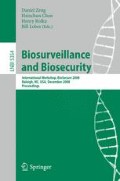Abstract
We developed a template-driven spatial-temporal multivariate outbreak simulator that can generate multiple data streams of outbreak data for evaluating detection algorithms used in disease surveillance systems. The simulator is controlled via intuitive parameters that describe features of the outbreak and surveillance system such as the elevated risk of disease, surveillance data coverage, case behavior probabilities, and the distribution of behavior times. We provide examples of temporal and spatial-temporal outbreak simulations. Our simulator is a useful tool for evaluating of outbreak detection algorithms.
Access this chapter
Tax calculation will be finalised at checkout
Purchases are for personal use only
Preview
Unable to display preview. Download preview PDF.
References
Wong, W.-K., Moore, A.W.: Classical time-series methods for biosurveillance. In: Wagner, M.M., Moore, A.W., Aryel, R.A. (eds.) Handbook of biosurveillance, pp. 217–234. Academic Press, New York (2006)
Lawson, A.B., Kleinman, K.: Spatial & syndromic surveillance for public health. John Wiley & Sons, West Sussex (2005)
Kulldorff, M., et al.: Multivariate scan statistics for disease surveillance. Statistics in Medicine 26(8), 1824–1833 (2007)
Hogan, W.R., et al.: The Bayesian aerosol release detector: an algorithm for detecting and characterizing outbreaks caused by an atmospheric release of Bacillus anthracis. Statistics in Medicine 26(29), 5225–5252 (2007)
Watkins, R.E., et al.: Using GIS to create synthetic disease outbreaks. BMC Medical Informatics & Decision Making 7, 4 (2007)
Reis, B.Y., Pagano, M., Mandl, K.D.: Using temporal context to improve biosurveillance. Proceedings of the National Academy of Sciences of the United States of America 100(4), 1961–1965 (2003)
Daniel, B.N., et al.: Detection of emerging space-time clusters. In: Proceedings of the eleventh ACM SIGKDD international conference on Knowledge discovery in data mining. ACM, Chicago (2005)
Cassa, C.A., et al.: A software tool for creating simulated outbreaks to benchmark surveillance systems. BMC Medical Informatics & Decision Making 5, 22 (2005)
Zhang, M., Wallstrom, G.L.: Template Driven Spatial Temporal Outbreak Simulation for Detection Algorithm Evaluation. In: AMIA Annual Symposium Proceedings/AMIA Symposium 2008 (in press, 2008)
Tsui, F.C., et al.: Technical description of RODS: a real-time public health surveillance system. Journal of the American Medical Informatics Association 10(5), 399–408 (2003)
Wagner, M.M., et al.: Design of a national retail data monitor for public health surveillance. Journal of the American Medical Informatics Association 10(5), 409–418 (2003)
Gilchrist, M.J.: A national laboratory network for bioterrorism: evolution from a prototype network of laboratories performing routine surveillance. Military Medicine 165(7 Suppl. 2), 28–31 (2000)
Hutwagner, L.C., et al.: Using laboratory-based surveillance data for prevention: an algorithm for detecting Salmonella outbreaks. Emerging Infectious Diseases 3(3), 395–400 (1997)
Author information
Authors and Affiliations
Editor information
Editors and Affiliations
Rights and permissions
Copyright information
© 2008 Springer-Verlag Berlin Heidelberg
About this paper
Cite this paper
Zhang, M., Kong, X., Wallstrom, G.L. (2008). Simulation of Multivariate Spatial-Temporal Outbreak Data for Detection Algorithm Evaluation. In: Zeng, D., Chen, H., Rolka, H., Lober, B. (eds) Biosurveillance and Biosecurity . BioSecure 2008. Lecture Notes in Computer Science(), vol 5354. Springer, Berlin, Heidelberg. https://doi.org/10.1007/978-3-540-89746-0_15
Download citation
DOI: https://doi.org/10.1007/978-3-540-89746-0_15
Publisher Name: Springer, Berlin, Heidelberg
Print ISBN: 978-3-540-89745-3
Online ISBN: 978-3-540-89746-0
eBook Packages: Computer ScienceComputer Science (R0)

